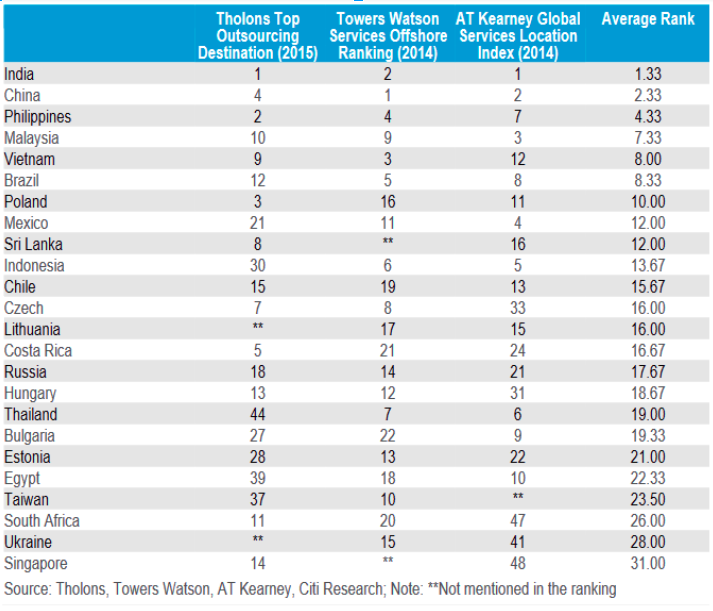This article was written as part of the work of the economic department of Center for Social and Labor Research.
New opportunities, old inequalities
Factories without workers, bullet trains and subways without drivers, robot cleaners and smart houses, multifunctional gadgets and 3D printers, electronic marketing, freelancing and sharing economy[i]. Today’s world is getting closer to the imaginary world of science-fiction writers. With the arrival of the digital age and the emergence of online services, simplification of industrial production through replacing humans with machines has not been the only feat of automation. The development of information and communications technology (ICT) and infrastructure expansion made it possible for digital technology to find its way into all stages of production process, from operation optimizing on a local level to creation of transnational chains of production of goods and services, which involve human labor from different parts of the world.
Due to involvement of digital technology, production process became faster and more productive. Routine mechanical work does not require human labor anymore, and the Internet opens access to information and mechanisms of direct involvement in decision-making. Automation should have opened a realm of new opportunities and helped the extension of democracy, reduction of labor hours and freeing up time for artistic work.
However, in the market economy environment, the access to benefits derived from new technologies, as well as to any other resources, is not equal. To this day, 60 percent of the world’s population do not have access to the Internet; therefore, they are not able to get involved in digital economy (World Bank 2016, 2). In addition, the studies show that, unlike the introduction of new technologies in the past, today’s benefits of technological changes are not widespread. Real average salary falls behind the growth of production efficiency, which only deepens socio-economic inequality (Citi & Oxford Martin School 2016, 7).
Competition for access to new technologies does not negate inequality among societies on a macro level or among individuals with different socio-economic capabilities; it only recreates the existing hierarchy by creating new mechanisms of exploitation. This, in turn, significantly limits the potential of possible social benefits of automation. Despite the technological development, productivity increase in advanced economies has been slowing down: from 4% during 1965-1975, to 2% during 1975-2005, all the way to 1% during 2005-2014 (Citi & Oxford Martin School 2016, 9).
Of course, due to socio-economic prerequisites, economically developed societies have more opportunities for introduction of new technologies. Nevertheless, with the development of coordination mechanisms and control over geographically dispersed production chains, automation process is slowing down even in the core countries. A possibility emerges to hire cheap labor from the outskirts, where the level of exploitation is higher and standards of labor protection are lower. This decision is easily explained by the simple logic of capitalist relations – cost minimization for profit maximization. For industrial enterprise owners in the USA and Germany, it would be less expensive to relocate their production facilities to poor African and Asian countries than to reequip the production at home (Dyer-Witheford 2015, 135).
On the class structure level, automation in the capitalist conditions of production results in polarization of the labor market and deepening of socio-economic inequality. It forces unskilled workers with low income to compete for low-paid jobs by creating a risk of them being laid off. Therefore, it is natural that individuals with higher levels of education and income, as well as with round-the-clock access to the Internet, have better chances of using the benefits of automation. (World Bank 2016).
In this investigative report, we plan to focus on inequality in distribution of automation benefits in societies with different levels of economic development. In addition, we want to consider social consequences of automation and production fragmentation and their effect on labor conditions in different countries. Among other things, we will analyze the economic growth prospects of developing countries (including Ukraine) under conditions of diffusion of innovations.
New technology and new mechanisms of exploitation
Optimistic forecasts of market ideology adherers are based on the existence of mechanisms of fighting the increase in unemployment rates, which compensate potential dangers of automation in terms of employment rates and working conditions. These mechanisms include:
- Use of new technologies stimulates emergence of new jobs. ICT sphere is one of the driving forces of economic development in OECD (The Organization for Economic Co-operation and Development) countries. In 2008-2013, 15-52% of investments in these societies were directed to IT sphere (Arntz et al. 2016). Research also shows that for every workplace created with the help of new technology, additional five workplaces are created (Moretti 2010; Goos et al. 2015).
- Technological development can raise business availability, as it increases its productivity. Lower production costs and lower prices drive up product demand. This, in turn, leads to increase in demand for labor.
- Automation should facilitate increase in labor productivity, which leads to pay rise or employment boost, or to both at the same time. As a result, workers would be able to consume more goods and services, which drives up the demand for labor (Arntz et al. 2016).
- If there is a decrease in demand for labor in any, it can result in reduction of working hours. During the recent decade, this practice has become common for many European countries (Spiezia & Vivarelli 2000).
Such positive picture clearly represents the processes in economically developed societies. Nevertheless, reducing the analysis of social outcomes of automation to only developed economies disregards side effects of technological development in core countries that affect societies, which were not able to accumulate enough resources to catch up with the leaders in the transition to the ‘postindustrial era’[ii]. That is why we should try to figure out the worldwide trends of technological restructuring of economy beyond the so-called ‘western world’.
As Nick Dyer-Witheford aptly noted, ‘contrary to many information-society claims, the overall share of industrial work in global employment has been relatively steady over recent decades. What is more, total manufacture output more than tripled over the four decades from 1970 to 2014 (United Nations 2014) during a period when world population did not even quite double. This is very far from fantasies of a ‘weightless’ or ‘immaterial’ digital economy. While large amounts of manufacturing work have been offshored from Europe and North America, significant tranches of industrial and other conventionally working-class labors survive, but increasingly in non-unionized, wage-tiered, casualized and deregulated forms’ (Dyer-Witheford 2015, 135).
Picture 1. The growth rate of industrial production during 2000-2014 by region (Source: UNO 2014 2014)[iii]
As it is clearly visible in the diagram (Picture 1), the growth rates of industrial production during the last 15 years differ greatly depending on the region. They are the lowest in the countries in Northern, Southern and Western Europe, as well as in North America, which can be classified as economically developed core societies, while industrial output continues to rise mostly in developing countries in Eastern and Southern Asia, Eastern and Western Africa, and in post-socialist societies in Eastern Europe.
Despite the fact that several non-western societies have been dealing with industrialization fairly well on their own, income inequality among countries has been significantly deepening since the times of Industrial revolution of the 18th century. In 1820, income rates in western societies was 1.9 times higher than in non-western countries (Maddison 2004). During the next 180 years, the West has taken a significant lead: in 2000, per capita income in western societies was 7.2 times higher than in non-western ones. Research shows that, in spite of improving their ability to implement new technology, developing countries still struggle with technological expansion. This was one of the main causes of uneven distribution of resources among regions of the world (Citi & Oxford Martin School 2016, 16).
The tendency of uneven distribution of benefits from implementing new technology is well illustrated by the robot production market. Economically developed countries with higher wage level are generally more prone to automation. First, robot maintenance requires a higher competence level than industrial work. Second, automation is beneficial in terms of profit maximization only on condition that the cost of acquisition and maintenance of robots is lower than the salaries of the industrial workers. For example, as calculated by Boston Consulting Group, operating robotic systems costs about 10-20 dollars per hour in the US, which is already lower than the average wage in industrial production. Moreover, trends show that during the next 10 years, replacing human labor with machines will be even more beneficial, and the percentage of production tasks performed by robots will increase from less than 10% to 40-45%. Top suppliers of industrial robots that will primarily benefit from this growth are located in economically developed societies, such as Japan (Yaskawa, Fanuc and Kawasaki), Germany (Kuka), Switzerland (ABB) (Citi & Oxford Martin School 2016, 26).
Based on the calculations of Boston Consulting Group (Sirkin et al. 2015), by 2025, robotics engineering will add to competitive performance of existing major industrial centers. In particular, Korea, Germany, China, Japan and the US during the next decade will only strengthen their position by increasing revenue from the use of robots. Developing societies can partially compensate for the losses caused by the lag in the production and use of robotics using other methods. For example, by improving the logistics infrastructure, which would allow importing goods instead of producing them. However, the speed with which robotics progress will not work in favor of poorer societies, which will continue to lag behind the implementation of technology in the production process (Citi & Oxford Martin School 2016, 28).
Even though second- and third-world countries are significantly inferior to developed economies in terms of technological re-equipment of production, it would be wrong to assume that automation has not affected employment and working conditions in poor societies. In addition to reduction of production costs through replacing human workers with robots, entrepreneurs in economically developed countries have another option: relocating the production to societies with cheap labor, as it has also become possible because of technological development.
ICT revolution, the second most powerful impulse for change in the production process after the Industrial revolution, made it possible to fragment the production and move it beyond state lines. The rapid decline in prices and improved performance of computing tools, as well as achievements in communication technologies make geographic division of different stages of production process more cost-effective. It became possible with the emergence of technological means for coordinating and controlling task performance over long distances. Therefore, the production process becomes more geographically fragmented between regions of the world (Citi & Oxford Martin School 2016, 20).
Global production chains do not stimulate industrial workers in poor countries to demand pay rise; by speaking up, workers face a risk of losing their job and being replaced by robots (Friends of Gongchao 2013). After all, if economically developed societies have certain mechanisms against influence of automation on unemployment rates, developing countries with low social security levels and economy, which depends on foreign investments would not bother to reeducate workers or to ensure proper employment level by reducing working hours (Arntz et al. 2016).
Apart from relocating the production plants, economically developed societies also exploit cheap labor through outsourcing people for nonphysical labor. In the past, the main advantage of computers over human labor was in performance of routine actions, which could be made into a computer code. However, taking into account most recent technological developments, an even wider range of non-routine tasks could be automated. This expansion of automation is centered around such technologies as machine learning, data mining, machine vision, computational statistics and other types of artificial intelligence. For instance, companies like Work Fusion sell software that allows automating non-routine tasks, which previously were performed by office workers. In particular, the software divides the work into smaller tasks, automates routine work and hires freelancers through crowdsourcing platforms for doing non-routine work. Software created for monitoring workers learns by reviewing people’s performance and eventually is able to automate new non-routine tasks. In other words, freelancers train the software for it to replace them in the future. Similarly, a growing amount of digital text translation allows intelligent software like Google Translate to compare and improve the quality of machine translation (Citi & Oxford Martin School 2016, 11).
Table 1. Global Ranking of Service Offshoring or Outsourcing Destinations (Source: Citi GPS: Global Perspectives and Solutions. University of Oxford 2016, p. 23)
As shown in Table 1, the service outsourcing and offshoring (as well as relocating production plants) is mostly concentrated in societies with cheaper labor than in core countries. It allows entrepreneurs to increase profits by reducing the cost of wages. For instance, the difference in labor costs in the software industry in India and the US in the early 2000s varied in the range of 1:6 and 1:10. The salary of a software engineer in the US was about $45,000 per year, while in India it was about $4,500. Of course, it is even easier to save on outsourcing of less skilled precarious work when tasks can be performed remotely (Ilavarasan 2007; Thibodeau 2012; Fuchs 2014).
Thus, rapid industrial growth in developing societies does not demonstrate the prospect of them catching up with core countries; it rather reveals the ability to relocate production to countries with cheaper labor. Accumulated profit potential based on implementation of modern technologies is available to economies that (i) focus on robotics and software engineering, (ii) benefit from displacement of human labor by machines due to high wages and (iii) have proper mechanisms in place to neutralize the automation impact on unemployment rates. Along with automation, core societies also experience the parallel process of geographically dispersed production fragmentation. As it is not yet possible to automate all operations, it is far more cost effective to relocate part of the production to the countries with cheaper labor and higher level of exploitation. This, in turn, only deteriorates poor working conditions in developing countries and makes their economy more dependent from foreign investments, aiding to maximize the profits of foreign entrepreneurs.
The paradox of higher risk of automation in developing societies
Based on the research methodology of the study of how susceptible jobs are to computerization (technical possibility of replacing human labor with automated technology) (Frey and Osborn, 2013), the latest World Bank report states that poorer countries are more susceptible to automation, even in comparison to developed economies with much higher labor costs (World Bank 2016). Susceptibility to automation in developing societies ranges from 55% in Uzbekistan to 85% in Ethiopia. A large portion of labor force with high risk of automation appears to be in China (77%) and India (69%). However, the average number for OECD countries is 57%. Even though societies with lower GDP per capita vary in their risks of automation, in general, they are more susceptible to displacement of human labor by computing technologies than economically developed countries, as is evident from the regression analysis below (Figure 2).
Figure 2. Countries susceptibility to automation is negatively associated with their GDP per capita (Source: Citi GPS: Global Perspectives and Solutions. University of Oxford 2016, p. 19).
It would seem that developing societies should be happy with technological development. However, the specific methodology of calculating the risks of automation should be considered. In particular, Frey and Osborne based their calculations on the number of jobs that involve routine tasks that can be automated. Overall, estimates of automation risks are usually based on the theoretical probability of replacing available jobs with technologies. However, they do not take into account whether these technologies are adaptable, and this causes the overestimation of the real impact of automation on certain jobs.
In fact, the implementation of new technologies is a slow process; it is caused by economic, legally and socially binding factors (OECD 2016, 3). On top of that, the poorer the society, the bigger the binding. After all, if the automation process in developed economies is slowing down mainly because of the possibility of production fragmentation (which combines the elements of automation and the search for cheaper labor abroad), in developing countries, it is generally unprofitable because of low labor costs and the lag in technological development. Moreover, availability of low-cost workforce in periphery countries minimizes the need in equipment upgrades that results in significant efficiency impairment, not to speak of implementation of modern technologies and displacement of human labor by machines. Specifically in Ukraine, production fixed assets are more than 80% depreciated. (State Statistics Service of Ukraine).
Therefore, the main reason of developing countries being more susceptible to automation is that these countries have more jobs that could be automated. As shown by a number of studies, laborsaving inventions may only be adopted if the access to cheap labor is scarce or prices of capital are relatively high. Case study evidence suggests that mechanization in 18th century cotton production initially only occurred in Britain because wage levels were much higher relative to prices of capital than in other countries. (Allen 2009). Thus, in a market economy where the main criterion of economic development is profit maximization rather than the need satisfaction, there is no point in hoping for rapid technological development of societies with cheap labor.
Working conditions and employment polarization
Partial automation in developed economies, along with production fragmentation, cause employment polarization. While unskilled labor is the most susceptible to automation, the ability to hire cheap labor abroad retains a great number of low-skilled workers in the occupational structure. Use and maintenance of new technologies requires employees that are more competent. Moreover, highly skilled work remains unautomated, as it requires such capabilities as creative intelligence (the ability to produce new ideas), social intelligence (understanding the social and cultural context), perception and control (ability to respond to events under unforeseen circumstances) (Citi & Oxford Martin School 2016, p. 19).
Polarizing employment into high- and low-skilled jobs, as well as into steady and precarious employment causes wage structure polarization into high- and low-paying jobs. In some societies, slumping demand for medium-skilled workers (due to it being the most automated type of labor) increased competition for low-paying jobs, which caused an even greater depreciation of low-skilled labor. At the same time, salaries for high-paying jobs have increased even further due to higher demand for highly skilled workers. Such trends could lead to increased poverty and preservation of poor working conditions (OECD 2015). It is also important to consider that the fragmentation of production made it possible to relocate production facilities to communities with lower standards of job security, worse working conditions and weaker opportunities for development of the trade union movement.
This transition to capital-intensive production method may also lead to a further decline in the share of labor in GDP and a further deepening of inequality. Changes in the employment structure cause the deepening inequality in development both societies and individuals, and the regions and settlements. New jobs are created mainly in large cities with high concentration of highly skilled employees, while other areas suffer from job losses (Berger and Frey, 2016).
What are the prospects for (semi) periphery societies?
Automation in periphery societies will stay cost-effective as long as it is cheaper to employ workers than to automate the production. Global economic trends do not indicate any prospects of radical change in the situation any time soon. Although the potential threat of increased unemployment due to automation can hurt the (semi) periphery much later than advanced economies, it may be potentially more disruptive in countries with limited social safety nets. What do the experts of economic research centers recommend the poorer countries in a situation like this? They recommend investing more in education and boosting domestic demand. According to Oxford economists, ‘because skilled jobs are substantially less susceptible to automation, the best hope for developing and emerging economies alike is to upskill their workforce’ (Citi & Oxford Martin School 2016, p. 19).
However, the existence of high-skilled workforce alone would not help the economic advancement of developing societies. For example, the number of university students and graduates in Ukraine is higher than the average number in the OECD countries (Muliavka 2016). However, lowering the social standards and rising prices, government targeting to preserve cheap labor under conditions of high availability and creating attractive investment climate for foreign capital does not ensure economic development in the long run. These steps only make cheap Ukrainian labor more attractive for foreign outsourcing.
For most developing societies, and especially Ukraine, aiming to attract western investors is considered a path to success. The Ukrainian government views relatively affordable education as an irrational cost allocation and employment in a foreign company is considered as the greatest success in life. Such path does not create potentially favorable conditions for economic development and improvement of the quality of life; it only preserves the inequality between core and (semi) periphery countries, leaving the latter in the third world status.
Certainly, developing countries need to expand access to higher education (and improve its quality). Education is an essential component for a developing democratic society, and it should perform a much bigger function than preparation for future profession. However, in the conditions of profit maximization at the expense of need fulfilment, labor time saving and relieving workers from routine work, there is no point in hoping that investments in human capital alone would contribute to the rapid economic development of poorer countries. It would only force highly skilled individuals to compete for low-paid jobs along with low-skilled workers, while only the chosen ones would be able to do freelance work for a foreign entrepreneur, earning only a small fraction of wages paid in developed economies.
Conclusions
The development of ICT and production automation potentially create possibilities for improving people’s living standards. However, in the market economy environment, these processes fit in the already established structure of global and class inequality, creating new exploitation mechanisms due to the following factors:
- Developed economies are more susceptible to automation, as they have (i) more expensive labor, and it is more cost-effective to replace it with computers and robots, (ii) more opportunities for ICT development and robot manufacturing, and (iii) mechanisms of neutralizing negative effects of automation on unemployment rates.
- ICT development enabled geographic fragmentation of production. This allowed core countries outsource cheap labor from poorer countries for performing unautomated tasks (because of low cost-effectiveness or inability to automate them).
- Processes of automation and transfer of production to societies with higher levels of exploitation and weaker trade unions lead to global deterioration of the working class and preservation of poor working conditions in the (semi) periphery countries: polarization of occupational structure and wages, rise in precarious employment levels, preservation of low standards of labor protection. At the same time, people with higher education, higher income and Internet access use the benefits of automation.- Current global inequalities are supported by local elites in developing societies that are only concerned about preserving cheap labor to attract foreign investments, and it only improves conditions for exploitation and does not contribute to economic development of poorer countries/
- Use of the potential of technological development for improving the quality of human life for everybody, requires a fundamental change in the logic of production and the transition from the market principle of profit maximization to primary focus on human needs, saving working time and relieving workers from routine work.
References
- World Bank (2016) Digital Dividends. World Development Report
- Citi GPS: Global Perspectives and Solutions. Technology at work v2.0. Oxford Martin School. University of Oxford 2016
- Dyer-Witheford, Nick (2015) ‘Cyber-Proletariat. Global Labour in the Digital Vortex’, London: Pluto Press
- Arntz, M., Gregory, T., & Zierahn, U. (2016). The Risk of Automation for Jobs in OECD Countries.
- Moretti E. (2010), “Local Multipliers”, American Economic Review: Papers and Proceedings, N100
- Goos M., J. Konnings and M Vandemeyer (2015) “Employment Growth in Europe: The Roles of Innovation, Local Job Multipliers and Institutions”, Utrecht School of Economic Discussion paper Series, Vol.15, No 10
- Spiezia V. & M. Vivarelli (2000) “The Analysis of Technological Change and Employment” in M. Pianta and M.Vivarelli, The Employment Impact of Innovation: Evidence and Policy, London: Routladge
- United Nations (2014) ‘National Accounts Main Aggregate Database. GDP/ Breakdown at Constant 2005 Prices in US Dollars (all regions)’,


![Picture 1. The growth rate of industrial production during 2000-2014 by region (Source: UNO 2014 2014)[iii]](/wp-content/uploads/2016/10/ris-1-1.png)






